Gabe Ets-Hokin
What’s the best first bike?
If your life is like mine, you get asked that a lot. I think it’s actually not a very good question, as there are a lot of unknowns in it. Best first bike for whom? For what? What will you do with it? How much money do you want to spend? How tall are you? Do you enjoy being terrified? And so on.
If you’ve never ridden a motorcycle before, an appropriate-sized learner bike should be your first moto-purchase. Motorcycles are like shoes—you buy what fits you now, not what you’ll “grow into” six or 12 months in the future. If you’re an average-sized person, small, lightweight bikes like the CBR250R or Ninja 300 can be good choices if you are already confident with basic operation of a motorcycle. But though I’m a small person (albeit, as the song says, Big in Japan), Americans are big people, and if you want to avoid being the proverbial monkey humping a football, you’ll want a bike with a small engine but large physical size.
A dual-sport is a good choice here, but what if you crave the sportbike riding position and look? There’s really only one choice, and you may be surprised it’s been with us for a long time in the form of the Hyosung GT250R.
Hyosung is an established manufacturer, maybe one of the oldest you’ve never heard of. Founded in 1962 as a trading operation, the company quickly got into nylon manufacture and grew to become a massive industrial concern. By 1978 Hyosung was license-building motorcycles for the South Korean market, and in 1986 opened an R&D department in Japan and began designing its own products. Hyosung motorcycles and quads saw our shores in the 2000s and have been sold by several importers.
The GT250 platform has been in the USA from almost the start, but it has been slowly improved and upgraded over the years. The full-faired GT250R joined the lineup, then fuel-injection came in 2010. It’s been pretty much the same for a while, and it’s been even more eclipsed by the wildly enthusiastic response to the Kawasaki Ninja 300R. So we’re just getting around to checking it out.
Yep, the Ninja 300 presents a high bar, so it’s unfair to make a direct comparison. But pit it against the Honda or the old Ninja—2012 or older—and the Hyosung isn’t looking too bad. The big tube-steel frame looks suspiciously like a Suzuki GS500E’s (not a bad thing—the GS500 is a pretty good-handling ride), but it offers lots of room between the wheels—the 56.5-inch wheelbase is a full inch longer than a Honda CBR1000RR, for instance—and the tall seat, almost 33 inches off the ground, will offer nice legroom for the long-of-leg, and panicky moments for the shorties. At 5-foot-7, I could mostly get my feet flat on the ground, but calling this 416-pound bike (3 pounds lighter than a GSX-R750) a “little” 250 indicates a conditional understanding of that word.
The chassis is finished with some surprisingly nice touches for a $4099 motorcycle. The bodywork’s styling is fresh enough to get admiring glances, there are decent passenger accommodations and a 4.5-gallon gas tank, and the digital dash, though hard to see sometimes in the daylight, offers adjustable backlighting. The mirrors are broad and give good visibility. The forks are large inverted units—the only bike in the class so equipped—but offer no adjustability. Rear shock has no damping adjustment, but does have a threaded adjuster for preload and works through a linkage. Tires are Shinko, in large-ish 110/70-17 and 150/70-17 sizes, and brakes are dual disc in front, with wooden-feeling TCIC (Tae Chung Industrial Corporation, in case you play with the “Korean Industry Superstars” set of Trivial Pursuit cards) two-piston calipers that Al reports “make an entertaining sound when you use them.”
The engine is a serviceable item that seems relatively basic despite some sophisticated touches. It is a dual overhead cam 249cc air/oil cooled v-twin, with an oversquare bore, fuel-injection and four valves per cylinder. It’s got a pretty mellow compression ratio—10.2:1, and the exhaust headers are garden-hose small. This means the motor feels like it’s not breathing as well as it could, and the dyno numbers bear this out—other publications have seen around 22-25 horsepower on the dyno. It’s slow-revving and not as smooth as a more modern liquid-cooled design might be, but it offers enough power to move the bike ahead of car traffic, offers a flexible powerband that’s easy to use and is good for a top speed well into the 90s.
And “nineties” is a good word to describe the GT250R. The riding position, big humped tank and general feel of the bike is Japan, Inc. c. 1994—and that’s a good thing, I think. The adjustable footpegs (nice touch!) and low clip-ons are classic Japanese sportbike, as are the chassis numbers. This makes the motorcycle feel stable in turns, with steering that’s high-effort for such a small bike. Suspension is surprisingly well sorted, even for me at 140 pounds and Big Al at…well, let’s just say at a lot more. I did experience some jarring from the back end, but I didn’t adjust the preload, and the forks are probably easily tuneable with $20 of fork oil and some spring-tuning. The tires seemed grippy enough, but are an unknown quantity and damped my enthusiasm for pushing it on cold winter rides.
Not that 25-ish hp can push 420-ish pounds very fast. On the freeway, it’s tolerable, and the bike actually isn’t too bad cruising at 80 mph. With enough downshifts and some rider chutzpah, you can pass cars at freeway speeds, and the wind protection and decent seat—coupled with observed fuel economy around 60 mpg (Hyosung claims 78 mpg)—will let you ride all day. For sport rides, the low motor output is perfect for student sportbikers—you learn to work the five-speed gearbox, how to conserve corner speed and to really ride, rather than just point-and-shooting like your big-bike mounted friends. Sure, they may leave you behind in the straights, but you can take solace in the fact that your bike is actually teaching you something.
With a limited two-year warranty (the second year is parts only), the GT250R represents a solid (but not great) value at $4099. I’d strongly recommend it to bigger riders looking for a sportbike that looks cool but is forgiving and suitable for learning—or somebody looking for a fun and frugal everyday commuter (you may want to also consider the naked GT250, which has an upright handlebar and $3799 MSRP). I really enjoyed my time on the Hyosung and am eager to try out the $5599 GT650.
Alan Lapp
Gabe and I were talking about the GT250R while I was shooting photos. We were both in agreement about the chassis stability: there is lots of it, perhaps too much. Our opinions coincided that the steering and turn-in are very heavy, which is emblematic of lots of stability-inducing trail. We concur about the engine: it’s adequate and manages highway speeds. The dual-front-disc brakes fell into the same category: surprisingly good for this category. Our like-mindedness extended to high praise for the appearance: it’s a handsome bike. Our solidarity included ergonomics—it feels a lot bigger than what is usually offered in the 250 class. My sole dissenting observation is that the rear shock is severely under-damped, but I am something like two Gabes.
In short, we were almost completely in harmony that this is an outstanding bike for some beginning riders (because it’s the size of a full-sized bike, the seat height isn’t especially low, which removes it from consideration for the inseam challenged). The GT250R doesn’t do anything surprising: it’s absurdly stable, has good-but-not-great brakes, the chassis goes where you point it with no drama, and the motor is tame and predictable. It’s a sane, fun, un-intimidating little bike, and that’s a good thing.
The GT-R is not perfect, however: the beginner-friendly slow-pull throttle (the opposite of a quick-pull) makes it wrist-breakingly difficult to reach full throttle, the LED instrument panel goes completely black when polarized sunglasses are used, and the shift lever throw is very long, making the shifting seem slow and notchy. That’s a pretty short list, two of which are very easily fixed.
The unexpected turn to the conversation came when we started discussing…racing. Yes, racing. Both Gabe and I are former racers, and it’s a touchstone for us. The local racing organization, AFM, has two classes for which this bike is eligible, 250 Production, and more interesting, 250 Superbike. The Ninja 250/300 is the dominant force in these classes. We discussed what it would take to make this bike into a competitive tool for Ninja beating.
The obvious shortcoming is the motor. It doesn’t rev very quickly, which is indicative that there is an air-flow restriction. It could be something as simple as a restrictor plate at the airbox intake, or under-sized exhaust. We believe that any competent tuner could find some more power in this motor. The OEM tires are a high-mileage compound, but in a fairly common size supported by race-tire manufacturers (Pilot Powers, for instance). Rubber brake lines are easily replaced with more-rigid braided-steel lines (though brake pads might be a problem). The upside-down forks could be sprung and valved, and a rear shock could be sourced from a builder that does custom work, such as RaceTech or Works (I suspect an older Japanese sportbike model may use a similar shock—ed.). Reducing weight would necessarily be another important step toward achieving a light, fun little race platform, but this bike has a lot of heavy-looking stuff attached to it.
So here is a Korean 250 at $4099 that can be competitive with the (somewhat more expensive) Japanese competition. Getting two ex-racers to see this kind of potential in an entry-level product is a real achievement for Hyosung. It’s a very user-friendly bike which runs well and looks great.
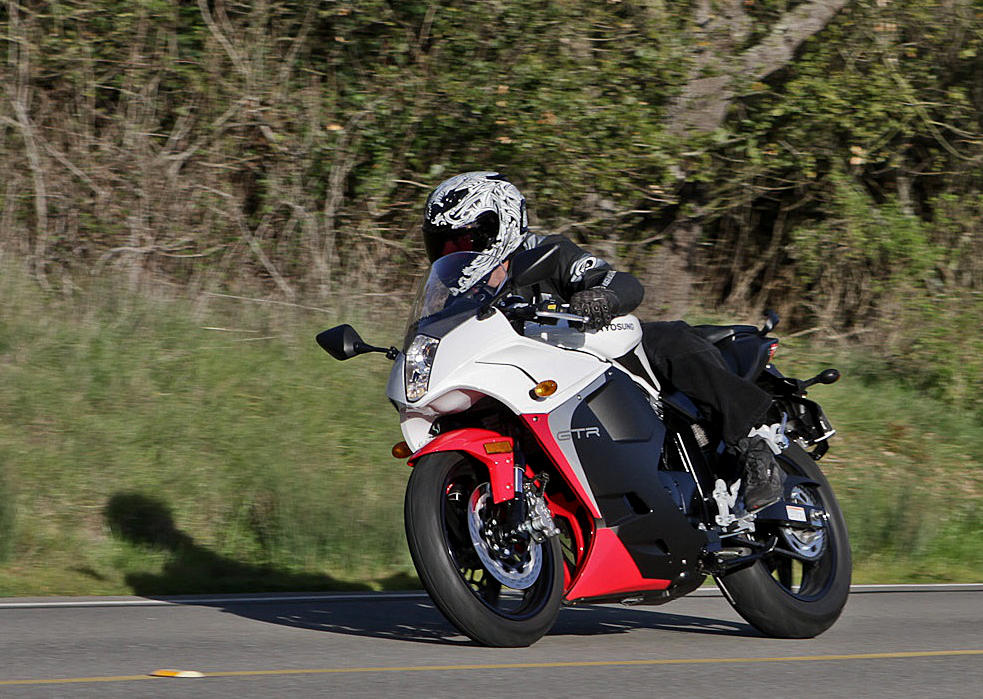
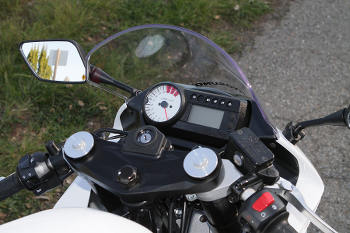
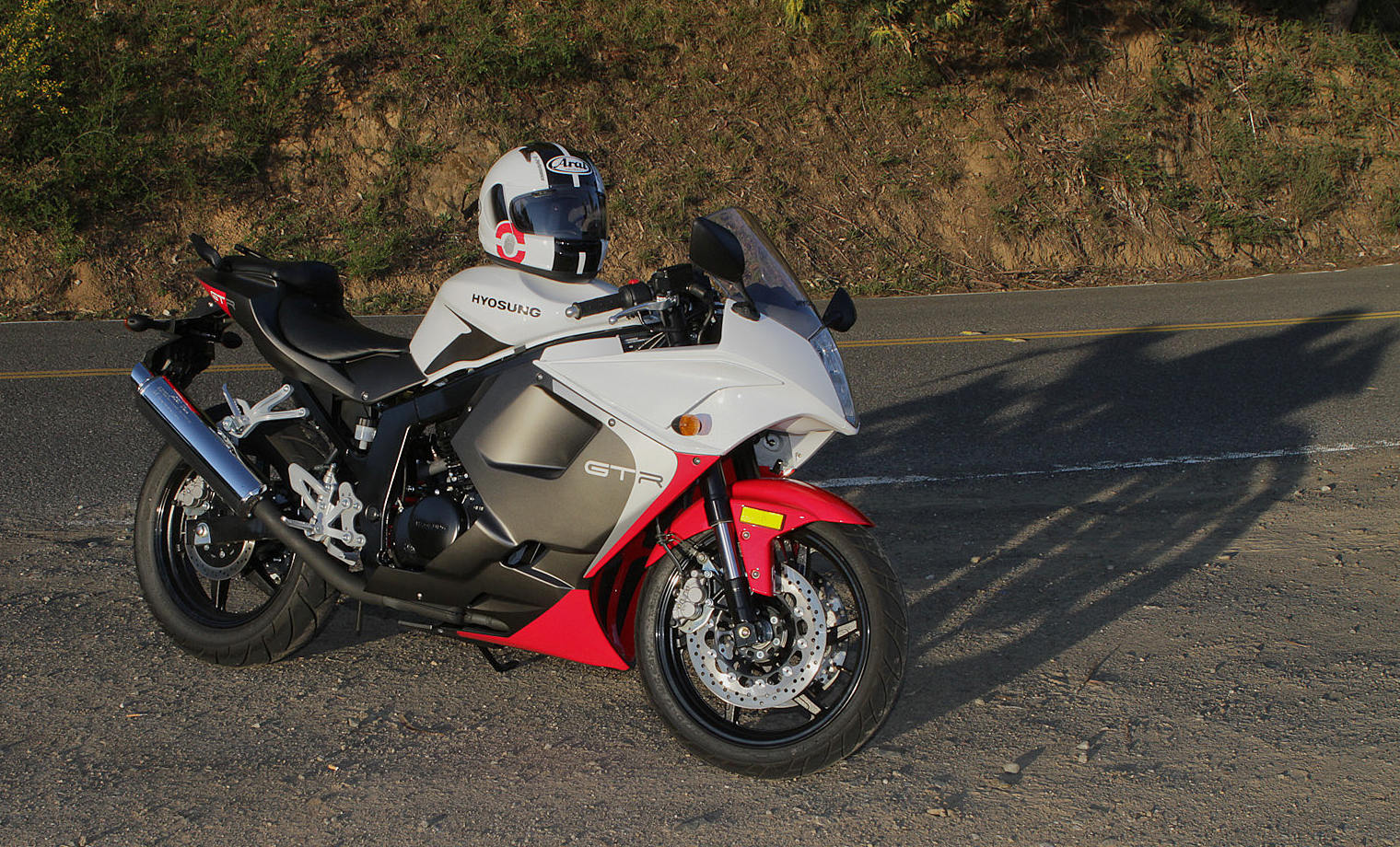
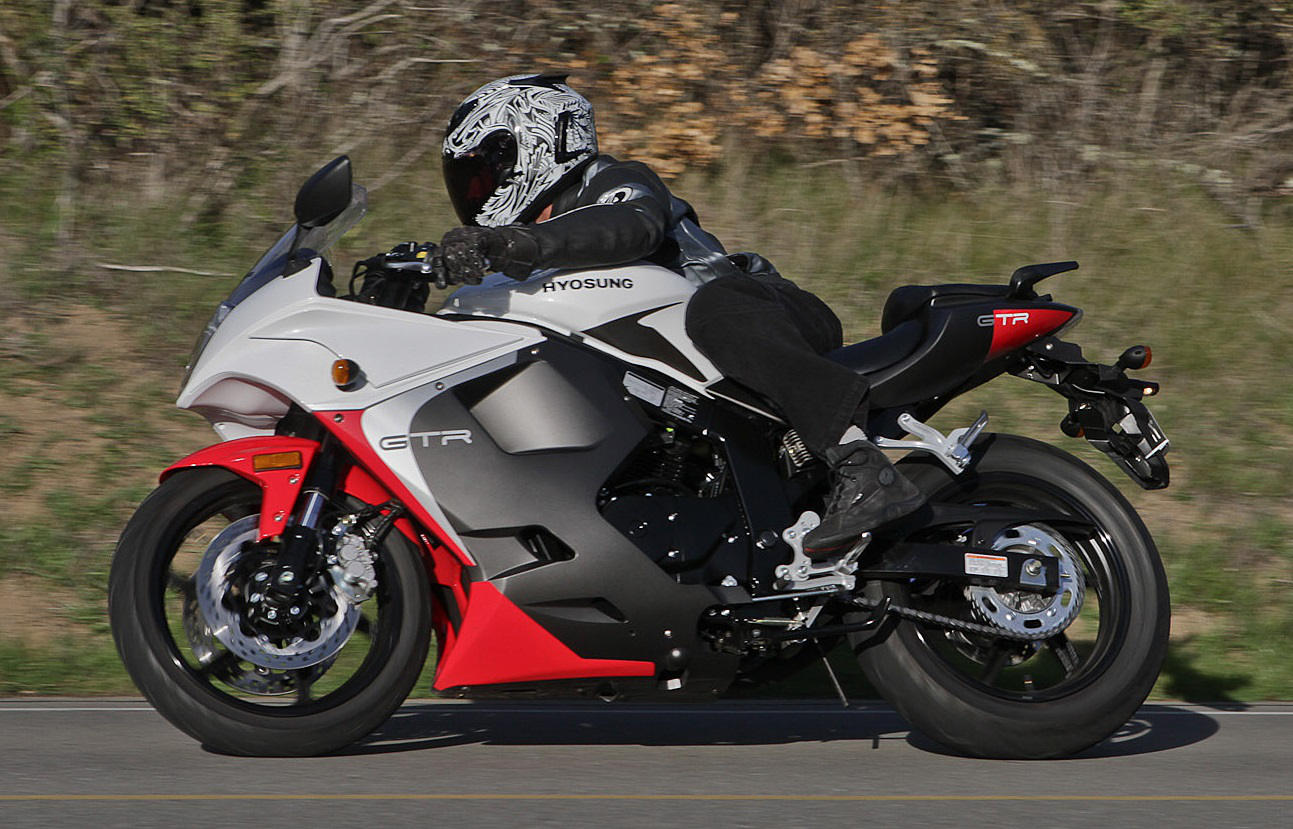
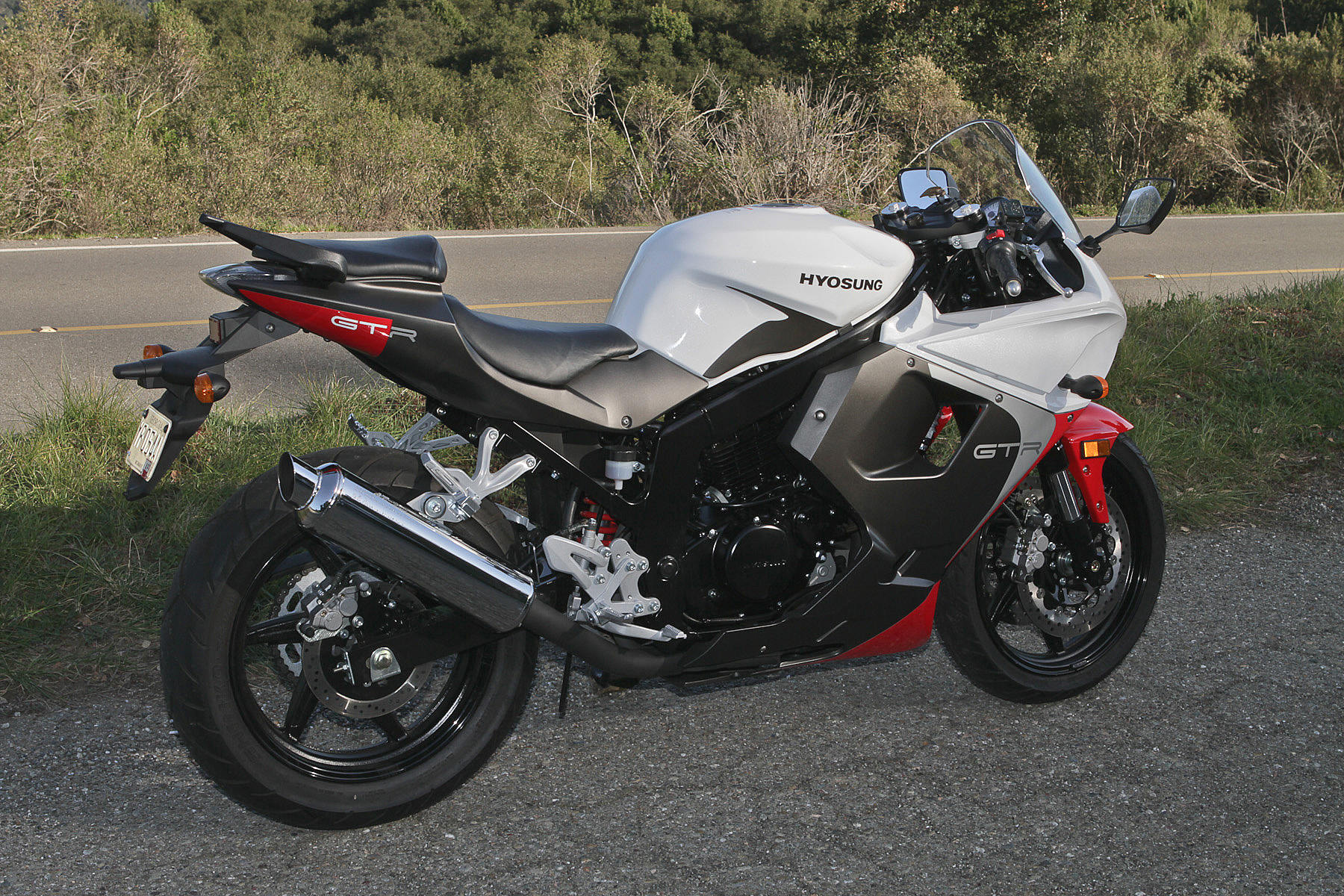






Glad to see you doing Hyosung reviews. Keep it up, I’m looking forward to more, especailly the upcoming X-5 250. They really manufacture some nice bikes.
I LOOKED AT THE NINJA 300..NO INVERTED FORKS..NO TRIPLE DISC BRAKES..NO 2 YR WARRANTY..KAWASAKI CUTTING CORNERS AGAIN..
WHY ARE YOU YELLING. YOU DO KNOW THAT YOU’RE YELLING RIGHT?
THATS NICE
The reason the Hyosung has a five-speed gearbox is because the engine has a much wider torque spread than the 250 Ninja. It will beat a 250 Ninja hands-down in a top-gear roll-on from 50 mph. From a standing start, a 250 Ninja will beat the Hyo in acceleration because it is lighter and has a screaming top-end. But in everyday riding, the Hyo is nicer. And for larger riders, cramped up on a 250 Ninja, the 250 Hyo will be superior. The 250 Hyo engine is good for at least 100,000 km before any work will need to be done, if it is serviced on schedule. Fuel range is 400 to 450 km, which is better than most big bikes.
The Ninja is more powerful than the Hyosung. More power means stronger acceleration. No way a heavier, less powerful bike can ever be faster than a lighter bike with superior power. I always thought this was obvious.
Maybe
http://www.msgroup.org/tip.aspx?num=221
That’s a really misleading article. When I ride my bicycle I can crank out nearly 150 ft-lb of torque, about twice as much as a Harley. Power is the measurement of how much work you can get out of your torque. Think of torque as “effort.” Just because you put in the effort does not mean you can get the job done as easy as someone who isn’t trying as hard. Torque is not an indication of power.
-todd
Ok, i have 2¢. If you are buying a small bore bike because it is your 1st, and you don’t want to get in over your head, then you are showing some self restraint. You could easily buy a 10 to 20 year old sport bike in good shape for half the money these little bike cost. If I were in charge (don’t worry I am the only one who thinks I should be in charge) I would build one chassis, but with two sets of ergos. Similar to small mx bikes with a big wheel option. One with small dimension and the other larger. Both bikes would get the same 80ish horse (to the wheels) motor. Then add an ignition that has different performance levels. Now you can make use of the engines torque with out it reaching for the sky. As you grow choose the hotter ignition. One chassis, one power plant, with a well thought out ecu. How many people can this one bike fit. The only problem is you may keep it, and not buy another bike next year. That said there are so many 250 bikes on craigslist i wonder who was the first to buy it new. I know more than one guy that has owned a 250, and the one that bought new regretted such a large investment for a bike he owned for about a year.
Also you could make full fairng, naked, and adventure (or as I like to call them) ujm or utility.
Everyone doesn’t buy a 250 just for a beginner bike. These are even a lot of fun for experienced riders who might want something with better mileage and be able to wring them out without getting into trouble like you would with a larger motor. Fun is the name of the game also with these. And yes, you can buy a used bike for less money, but then again, it is USED. Then there’s the not-everyone-has-one thing. If everyone has the same bike, the one that has something different really stands out.
You are correct from all points, but my point is different. From a manufacturing point everyone wants the bike worth producing ie-cbr600f, f2, f3, (not the f4 the moment was gone by then). This keeps tooling cost low, which should translate into three models, all with large small option. That should help keep purchase cost down. As unglamours as it was the Kcar save chrysler from death.
buy a clean low miles SV650 for about $2500 and don’t rev it past 5000 RPMs.
Why even bother with this bike when the Kawasaki 300 is available?
You could read the story and find out.
For one, I learned to ride on a 98 N250. It was SMALL (I am 6-2). Granted, I only sold the bike when I moved out of CA (good thing, hard to get them jetted right at high altitude), but it was literally too small for me.
If Kawi made the 300 more full-sized (or a triple 400 or so?) I’d have one in a flash.
So that part of this bike’s makeup was actually interesting to hear about….
“You could read the story and find out.”
We did. I read it to say that if you must have a physically larger small displacement bike than a CBR 250 or Ninja 300 and a Dual Sport won’t do then this is your only choice.
Please get to grips with the difference between LED and LCD, my teeth grind everytime someone mixes the two up.
LEDs (Light Emitting Diodes) emit light, are sometimes used in car displays but rarely (never??) used in bike displays and are completely unaffected by polarized sunglasses.
LCD (Liquid Crystal Display) either transmit or reflect light and are dependant on polarizing filters. Polarization is usually horizontal or vertical. If the display polarization matches the sunglasses you will see display, if it is opposite, you will not. A budget bike builder who can’t even get this correct deserves a miss.
409 pounds is a lot of weight for a bike that will probably spend a bit of time leaned over to the point of loosing its grip on the pavement. A beginner would be much better off with a smaller bike.
I disagree. I have a `00 MZ Tour 660 single that is the best corner handling bike I’ve ever ridden in 50 years of riding. Even 2up on it going thru corners is a new experience !!! It has a 110/70-17 front tire and a 140/70-17 rear tire. 400#s on it feels like not much. ; ^ )
You miss the point. I wrote that for a NEW RIDER a 409 LB bike would be excessively heavy. Your 50 years of experience are at the other end of experience spectrum. A n00b would do a lot better on a bike with no plastic and 100lb lighter.
+ 1, agree ^^^.
If there’s one big problem with motorcycling in America — where graduated licensing doesn’t exist — it’s new riders buying bikes way too big for them.
Maybe 400# feels heavy to you, but it doesn’t to me. My first bike in the mid-60’s was a new Yamaha 250 2-stroke with 20hp and a 4 speed tranny that did up to 85 mph. I figure it weighed something like 300#. At the time I weighed 160#. 1 of my favorite rides now is a 250 MP3 w/22.5 hp that weighs 450# and does up to 77 mph top speed. I started on a 250 and now have a 250 again. I use my MP3 for local rides.
I am not sure I get your point. Are you implying that the limits of the bike would be reached sooner (such as when a new rider enters a corner too hot) on this bike vs a lighter option like the 250R? I think a new rider will exceed their skill level in such a scenario long before they approach the limits of either bike.
The essence of the article is that if you buy this, spend maybe $1000 (exhaust, suspension work, brake lines, tires) to help it develop, you still won’t have a 300 Ninja. Another aspect to the purchase of less recognized brands are dealer support and resale difficulties, which is a very significant issue with this ‘gateway’ class of motorcycles.
As we’ve seen with car manufacturers, by the time these guys have got their product development half finished, they’ve lost their price advantage. It’d be a very specific detail that would make someone buy this over the Kawasaki or Honda alternatives.
I’d be tempted to play or modify a vtwin over a parallel twin or single. Think beginner Duc. Just a thought.
If a beginner has the money and is set on buying a new bike this is maybe a good choice. I will assume however such a buyer if they continue riding will be upgrading in a couple of years at which point the $700 or so lower price difference from the Honda or Kawasaki would mostly depreciate away. So the cost of ownership will not be much lower.
I have not been asked in a long time but I always recommend a used bike to a new rider.
For some perspective on used, not a new rider bike of course. I got my 04 ZZR1200 with 1900 miles on it last May for $5000. It’s almost painful to think one can buy a bike 50 times better than they little GT 250 for only 20% more dollars.
I’m with you on the used bike over new beginner bike. You just pray the beginners also are beginners with prices and finance. That newbie on your ZZR is a recipe for disaster. A friend just sold a 250 Virago(to a complete newbie) for $1800, I’m glad he didn’t see my GS1100 for only $400 more.
Hyosung is not yet so popular in the US. But if you go Europe or Australia you can see they dominate the streets. They’ ll soon be popular here in the US too. That’s what I think.
My first bike was a 2006 gt250r. Then I bought a 2012 one. I started with this bike, I will keep this bike until I go for bigger machines. I am 6 3 and 170pounds. This bike does whatever I want even with my gf on the back.
If you want to buy a bike easy to handle but with a great look, you should go for this one. It’s big. Often people ask me if it’s 600 or even 1000 ! Great on gas. About 60-70mpg.
For $4000 that’s the best choice for a beginner. Even for a regular rider. Only thing bothers me is the exhaust pipe. They should do it black.
So Gabe – when will we see the follow-up article on simple mods to improve the performance on this bike? Better tires, a stage 2 or 3 engine tune and stripping some off some fat sounds cheap enough. Maybe Hyosung will let you hold on to the little booger for some ‘experimenting’.
meant ‘stripping off some fat’
I’ll try to make something happen!
I’ll be waiting. Everybody is gonna be doing the Kaw/CBR hop ups. I think the Hyo will sound better when done, BUT,,,,, it’s a motorcycle not a stereo.
Seems like your money would be better spent paying the premium on a Ninja 300. Just sayin’.
What if one doesn’t want a Ninja 300 because it doesn’t fit?
Hah! That is the point of the point of the article I suppose.
If the bits remind you of a Suzuki that’s because Hyosung and Suzuki had a relationship spanning all the way back to 1979. Where do you think all those little, inexpensive Suzukis came from?
-todd
With modern electronics, manufacturers could put a “beginner” setting on just about any bike. Then one could get the bike they wanted, have plenty freeway power and truly grow into it.
That wouldn’t cure the occasional parking lot speed dumps that come with learning to control a bike, especially on taller, heavier bikes, but I think it would be a better option for a lot of people than these small displacement wheezers.
The technology is already there in the form of aftermarket limiters. At least in Europe. Since beginning riders are limited to low powered bikes, one way to circumvent the restriction is to put a limiter on a larger displacement bike. Think 500-600cc limited to 250-300cc (roughly). The problem is that they currently only really limit revs and power, no matter the gear, which can make a heavier larger capacity bike unwiedly. America is really the only market that refuses to embrace a small displacement bike. “Bigger has to be better.”
The technology is also present in any ride-by-wire system. Everything from fuel to spark timing can be controlled. No need to mess with a limiter in the near future. America refuses to embraced small-displacement bikes because 1) they don’t make as much sense here as they do in other countries, and 2) we are not required to buy them in order to graduate to the next tier of licensing.
do they have an electronics setting that makes the bike lighter, less expensive, and more nimble? That’s a lot to give up just so you could feel proud of yourself for having a “big” bike like all the “big boys” have.
-todd
Good point Todd. And do they have an electronics setting that achieves fuel economy in the 70-80 mpg range, and an electronics setting that lowers insurance rates, and price of maintenance and parts? Didn’t think so.
I didn’t say a “beginner” setting on larger machines would be a replacement for small displacement bikes, I said it would be a better option for many. Lighter, cheaper and nimbler isn’t much to give up at all if you don’t value those qualities. A Ducati Monster 800 would be lighter and nimbler than this particular bike with much better brakes and suspension. If you could afford a mild Monster that you could ramp up as your skills improved, why not?
Small displacement bikes have their niche, and I am glad to finally see a quantum leap in the quality of the offerings for that segment. I just don’t think they are the best answer for everyone.
I have a Monster 900. No way is it more nimble or even lighter than this or a Ninja 250. The Monster feels a bit top heavy and slow steering compared to the ninja but it does wheelies much better…
-todd
It looks nice .Thats about all I can say for it.
behold, the power of packaging.
When I started riding in the mid-sixties it was small trailbikes and the like. We rode every chance we could, good or poor weather. Learning to control a motorcycle in conditions rarely found on the street gave me the extra skills and confidence I needed when I got my license.
My first bike was a Yamaha DT175, which taught me not only riding, but the correct way to crash. You won’t learn your limits unless you occasionally exceed them. Except for one fractured leg, it was pain-free.
in 1981 I wanted to ride. I decided to skip the smallish first bike for a new red 1981 Suzuki gs750ex. with the birth of my first I sold her with 10,000 problem free miles. I will never forget that 5000 to redline howl.
And if I ever have kids I won’t be selling any bikes.
I have an alternate answer for the “best first bike” question – but perhaps more applicable to the returning biker. I took a three year break from riding a motorcycle when I developed an interest in mountain bike XC endurance racing. The training and skills development that went with the cycling gave me a lot more confidence, muscle strength (both leg and core)and joint flexibility when I returned to motorbikes, in addition to the expected balance skills. I personally recommend the old fashioned bicycle as a training tool for anyone looking at improving their motorcycle confidence.
Theres a reason GP riders train on cycles in the off season.
Agree with this, a good bike.
For a new bike at $4000, that looks and feels like an entry level sportbike, this is a viable and even attractive option in the USA. It is good looking. Those forks add real value in the way of chassis stiffness, even though not quickly tunable. Yes it is easy to swap the shock for a real one, used, from a late model japanese sportbike for low $.
…If you have a decent dealer nearby who won’t try to talk you into an entry level kawasaki.
The GT250 has a decent forum, a requirement for any bike. Some smart people take these bikes seriously there.
It has a lot in common with the ancient GS500 for sure and that GS was a very good thing.
The 75 degree conjunction of cylinders cannot be engineered out by astute tuners nor can a balance shaft be added. It needs some more Suzuki DNA.
I was unable to get my downdraft Mikunis to work right on my 2004.
Hyosung sold this bike division off, its not backed by the Hyosung mother ship. I can’t see much on S&T group. They have a modern looking compact naked watercooled 250 single out there for release in Autumn 2013. The X-5. Not a great name. Not sure the US will get it. It would sell well here if it is what it looks like what it wants to be.
The real battle for this Hyosung is against a used bike. For first time new riders entering sport wanting a factory fresh bike, against ex300, CBR250, and the new Suzuki 250, this Hyosung is viable and has its advantages. It can also appeal to those with long experience who want to enjoy the basics, just like the EX300.
Needs a good dealer.
Not bad looking
one word… plasti… err packaging.
For Hyosung to get to ex-racers to see the potential in this bike is a real achievement for sure, now if this article could get Hyosung to tap the potential in this bike that would be a real accomplishment.
That kind of cash for a marginally proven manufacturer with small US dealer network is a rough one to swallow. The Kawasaki offerings aren’t THAT much more expensive and I would venture to guess the quality and performance is still worth a couple hundred bucks more. Seems like this bike is a few hundred overpriced…and forget about resale!
The argument that this is a larger motorcycle for those larger people is probably a bit moot. Consider that those folks might be able to use a bit more power anyways and can muscle around a larger displacement motorcycle with no issues. The various 600/650 class non-race reps or the new Honda 500’s would better suit.
In all cases, a slightly used SV650, GS500, Ninja 650/500/250 etc all seem like better values. I guess I just think back to the day I bought a brand new SV650S in 2003 for $5200 OTD. I know those times are gone now though!
re: “I know those times are gone now though!”
they’re over johnny…
https://www.youtube.com/watch?v=QiZdY9rw-uo
“Consider that those folks might be able to use a bit more power anyways and can muscle around a larger displacement motorcycle with no issues.”
Oh lord, here we go again. http://faq.ninja250.org/wiki/Why_sportbikes_are_NOT_beginner_bikes
In other words, you don’t “muscle around” ANY bike. Expecting to do so with much more power (even in non-supersport bikes you mention) is completely missing any point about learning to ride vs. how easily you can get over/on your head.